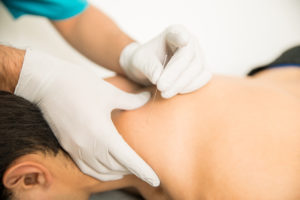The Science Behind Dry Needling
 Though it is a traditional and ancient Chinese practice, acupuncture has become a popular therapy worldwide. By inserting needles along the body’s energy meridians, acupuncture has been able to help restore the body’s energy and treat a wide range of conditions. Fox Integrated Health offers a Westernized form of acupuncture known as dry needling, which applies Western medical principles to the practice of acupuncture. Dry needling is exceptionally effective and proven as a form of healing. Read on to learn more about the practice and whether it may be a good fit for your needs.
Though it is a traditional and ancient Chinese practice, acupuncture has become a popular therapy worldwide. By inserting needles along the body’s energy meridians, acupuncture has been able to help restore the body’s energy and treat a wide range of conditions. Fox Integrated Health offers a Westernized form of acupuncture known as dry needling, which applies Western medical principles to the practice of acupuncture. Dry needling is exceptionally effective and proven as a form of healing. Read on to learn more about the practice and whether it may be a good fit for your needs.
About Dry Needling
To an outside observer, dry needling looks just like a traditional acupuncture session. Ultra-thin needles are carefully placed throughout the body in order to stimulate the body below the skin. The needles do not deliver any liquid, hence why they are known as dry needles. The difference between the two practices lies in where the needles are focused.
Traditional acupuncture focuses on a holistic approach to the body’s energy centers, while dry needling emphasizes bands of tight muscles, called trigger points. The philosophy behind dry needling is that the needle stimulates these muscle areas, triggering relaxation within the band of muscles and stimulating blood flow.
When a trigger point is activated, it forces localized blood flow and muscle relaxation, leading to benefits that include:
- Reduction of pain through the diversion of the pain signal away from the spinal cord.
- Helping to “reprogram” the area in order to restore the natural activation patterns of muscles.
- Improvement in range of motion.
- Reduction in inflammation.
- Stimulating the body’s natural healing reflex
What Can Dry Needling Treat?
The primary use for dry needling is orthopedic treatment. This can include:
- Head and Neck Pain: headaches, migraines, whiplash, osteoarthritis, degenerative joint disease.
- Back and Hip Pain: herniated disc, degenerative disc disease.
- Hand and Wrist Pain: carpal tunnel syndrome.
- Shoulder Pain: bursitis, tendonitis, rotator cuff, frozen shoulder.
- Elbow Pain: tennis and golfer’s elbow.
- Foot and Shin Pain: plantar fasciitis, shin splints, metatarsalgia, gout.
- Other Painful Conditions: ear, eye, dental, and orthodontic issues, including cavity pain, tooth impaction, and root issues, tinnitus, and eye strain.
- General Pain: post-surgical recovery, pain from car accidents, workplace injury, athletic and sports injuries, osteoarthritis, degenerative joint disease, acute or chronic tendonitis.
Science and Dry Needling
As mentioned, the mechanics of dry needling are significantly different from those of traditional acupuncture. When a dry needling practitioner assesses a patient, they identify special muscular areas known as myofascial trigger points. When these points are stimulated with a needle, they cause a local twitch response, activating endogenous opioids that counteract pain.
Additionally, blood flow stimulation is activated. The introduction of minor trauma by way of a needle to the muscle triggers mechanoreceptors in the body, sending a signal that healing is required to that region. The body responds by sending oxygen-carrying blood directly to that area.
The result of these mechanisms is a decrease of pain due to opioid release, as well as the promotion of healing, relaxation, and anti-inflammation.
Dry Needling vs. Acupuncture
Because of the similarities in practices, you may not be sure if dry needling or traditional acupuncture is right for you. In general, a holistic approach to health is always best, and there is not necessarily a reason to choose one over the other. The two can work together nicely. However, dry needling tends to be focused on more specific conditions than acupuncture and has the added benefit of being based in Western medical practices.
The science that underpins the practice of dry needling makes it a compelling choice for someone who is not ready to explore alternative therapies but wants to benefit from the stimulation of needle-based treatment.
What To Expect During Dry Needling
Dry needling should always be performed by a licensed and trained physical therapist who is working in conjunction with your health team at large to develop a care plan.
At Fox Integrated Health, a licensed practitioner will begin by inserting fine filament needles into your identified trigger points and the surrounding tissue. You may experience slight, brief pinching sensations as the needles are inserted but no further pain. Localized twitching may also be noticeable, which can be odd or uncomfortable but not painful. Treatment is usually brief, and you will be able to continue your day as normal.
